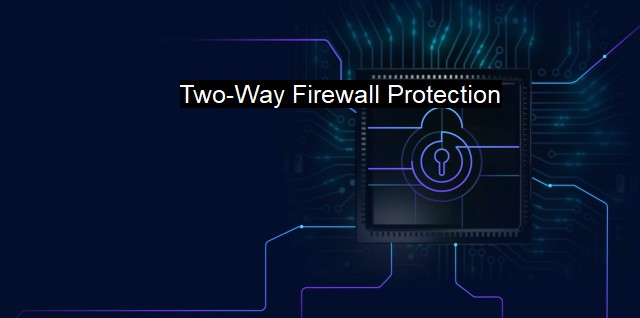What is Two-Way Firewall Protection?
Enhancing Cybersecurity with Two-Way Firewall Protection: Understanding How it Works and Why You Need It in Today's Threat Landscape
A two-way firewall protection, also known as a bidirectional firewall, resides within the rich chorography of cybersecurity measures employed to prevent malicious attacks from endangering the sanctity of a system. This cybersecurity tool essentially functions as a digital barricade that prevents unauthorized web services from gaining access to your private network. The term “two-way” or “bidirectional” is of core pertinence here, as it underlines a salient feature of this firewall — its ability to regulate internet traffic that comes and goes from your protected network in both directions: the incoming and outgoing traffic.Situated at the very nucleus of the internet security framework, the two-way firewall accord impetus to the first line of defense against cyber attackers that stealthily target your computer system. Its chief mandate is to extend blanket protection to your system by meticulously monitoring every packet of data that either enters or exits its protective periphery.
Certain kinds of malware can seize control of existing programs on your unprotected computer, thus steering towards unauthorized outbound connections. A one-way firewall, or an inbound firewall, accomplishes the fundamental task of preventing unauthorized access or intrusion from suspicious external sources. it does not offer adequate protection against such malware-initiated outbound connections. These gaps in protection are effectively filled by a two-way firewall that introduces a stringent layer of outbound protection, scanning for harmful programs that might cause an internal program to initiate unauthorized communications with external sources.
The efficacy of a bidirectional firewall arises from its scrupulous modus operandi that includes assessing legitimate connections based on a predefined set of rules and filters. This predefined rule set embodies permissive, prohibitory, or restrictive standards that govern the flow of traffic. Firewalls discern packets of data presenting valid credentials, allowing passage based on trusted IP addresses, port numbers, or protocols. Whilst delineating protection mechanisms, the two-way firewall thus forestalls cyber threats.
A bidirectional firewall primarily comprises of two components: stateful inspection and packet filtering. Stateful inspection scrutinizes each incoming and outgoing data packet's state, ports, and protocol, while gauging whether it aligns with the user's authorized and established sessions for secure internet browsing. If the system construes deviation or unfamiliarity, alarm bells are triggered. As for packet filtering, it validates or rejects data packets based on an established rule set that primarily focuses on IP addresses and ports.
A critical component to antivirus programs, the two-way firewall not only mitigates the risk of Internet-based threats but also eschews harmful traffic generated from within a user’s system. They closely coordinate with antivirus software, further bolstering the shield against cyber threats entailing viruses, Trojan horses, worms, spyware, and other kinds of malware.
Dealing with a two-way firewall mandates precision and cognizant handling. Emphasis ought to be placed on action setting configurations and accurate firewall rules to steer clear of debilitating breaches, whilst ensuring unobstructed, secure, day-to-day web operations for the user. Periodic tweaks further complement the firewall’s then-current protective capacities.
Two-way firewall protection emerges as a holistic solution to the persisting issue of escalating cyber threats. Its vigilant eyes perpetually monitor the inflow and outflow of data ensuring no malignant activity either gains access or sneaks out unobserved. Concurrently, it works alongside antivirus protections enhancing the assurance of safety to your system. Where hackers continually strive to outsmart internet security provisions, innovations like two-way firewalls raise high fortification walls that reassure an immensely more secure digital environment. Therefore, the shrewd implementation of two-way firewall protection posits a pivotal point of reference when considering the architecture of your system's security.

Two-Way Firewall Protection FAQs
What is two-way firewall protection?
Two-way firewall protection is a security measure that helps prevent unauthorized access to a computer network. It monitors both incoming and outgoing traffic, allowing only authorized communication to pass through while blocking malicious traffic.What are the benefits of using a two-way firewall?
The benefits of using a two-way firewall include better protection against malware, increased control over network traffic, and improved visibility into network activity. It also helps to prevent data breaches and maintain the integrity of confidential information.How does a two-way firewall differ from a traditional firewall?
A traditional firewall only monitors incoming traffic, whereas a two-way firewall monitors both incoming and outgoing traffic. This additional layer of protection helps to prevent malicious activity that may initiate from within the network.Is a two-way firewall enough to protect my computer from cyber threats?
While a two-way firewall is an important security measure, it is not enough on its own to protect your computer from all cyber threats. It should be used in combination with other security measures such as antivirus software, regular updates, strong passwords, and safe browsing habits.| | A | | | B | | | C | | | D | | | E | | | F | | | G | | | H | | | I | | | J | | | K | | | L | | | M | |
| | N | | | O | | | P | | | Q | | | R | | | S | | | T | | | U | | | V | | | W | | | X | | | Y | | | Z | |
| | 1 | | | 2 | | | 3 | | | 4 | | | 7 | | | 8 | | |||||||